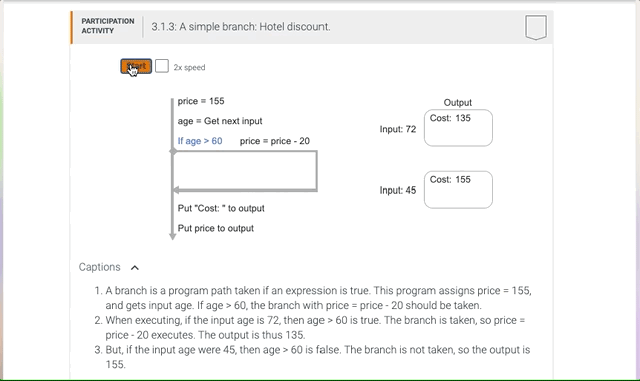Integrating Learning Sciences in STEM: The zyBooks Model
As STEM educators, you are likely confronted with an ever-growing list of educational technologies that claim to engage students and enhance their learning. But how do you know which of these technologies actually work? At zyBooks, we embrace the principles of learning sciences to create digital courseware that not only captivates students, but also significantly improves their academic performance. Here’s how we integrate these best practices into our product and what you should consider as you evaluate other products.
Best Practices for zyBooks Design
- Managing cognitive load
- Enhancing engagement and motivation
- Providing timely and explicit feedback
- Minimalistic and student-focused design
- Leveraging multimedia for better learning
- Proven results
1. Managing cognitive load
According to Mayer’s Cognitive Theory of Multimedia Learning, learning is optimized when cognitive resources are efficiently allocated. In other words, effective educational technologies are those that present content in small, bite-size pieces. At zyBooks, we achieve this by:
Segmenting Content
Our content is broken down into manageable chunks, allowing students to process information without feeling overwhelmed. Each zyBook subsection is designed to be completed in 5-10 minutes, providing natural breaks in the material.
Pretraining
We introduce key terms and concepts before diving into complex processes. This helps students build a solid foundation, making it easier to integrate new information.
2. Providing timely and explicit feedback
Engagement is a significant factor in student success. Although you are probably accustomed to preparing engaging in-class activities, we think about engaging students outside of class. We use several strategies to maintain students’ attention and motivation:
Interactive Components
Our Say-Show-Ask framework ensures that students are actively involved in their learning. The “Say” component introduces the topic concisely, the “Show” component uses visuals and animations to explain concepts, and the “Ask” component includes questions that serve as an interactive form of reading.
Real-Life Examples
We incorporate real-life scenarios and thought-provoking questions to make the content relevant and interesting.

“We are committed to continuously improving our platform based on research and feedback to support educators like you in delivering the best possible education to your students.”
3. Providing timely and explicit feedback
Feedback facilitates learning. It helps students master the content and evaluate their progress. Some educational technologies offer feedback, but the feedback is only surface-level. At zyBooks, we ensure feedback is both timely and explicit through:
Immediate Feedback
Our platform provides instant feedback on learning questions and activities, helping students understand their mistakes to enable learning from those mistakes.
Detailed Explanations
Feedback is not just about correctness; we provide detailed explanations for both correct and incorrect answers, addressing common misconceptions and guiding students toward the right understanding.
Review the Research
Incorporating Learning Sciences’ Best Practices Into STEM Courseware
4. Minimalistic and student-focused design
Cognitive load can be reduced through a minimalistic design. Consider a typical textbook page. It probably contains multiple heading levels and call-out boxes, each with a different font style, size, and color. Although visual organizers are important, they are frequently overdone. We avoid overwhelming students with extraneous information by using:
Concise Text
zyBooks’ content is concise and to the point, ensuring that students spend less time passively reading so they don’t lose focus. Instead, students spend more time actively engaging with the material.
Simple Visuals
Visuals are stripped of unnecessary details, focusing only on the essential message to aid understanding.
5. Leveraging multimedia for better learning
Returning to Mayer’s Cognitive Theory of Multimedia Learning, Mayer and other researchers conclude that students learn better from words and pictures, versus words alone. However, beware of educational technologies that incorporate multimedia without a pedagogical reason. zyBooks authors use multimedia judiciously through:
Animations
Carefully designed animations help illustrate dynamic processes, reducing the need for students to make inferences, which lowers the cognitive load.

Multimodal Learning
By combining text, visuals, and interactive elements, we cater to different learning styles and promote deeper understanding.
6. Proven results
Our approach has shown significant positive impacts on student performance and engagement such as:
Improved Grades
Studies have shown that students using zyBooks perform better academically, with improvements in course grades and exam scores. See more about this here.
Reduced Attrition
Courses that have adopted zyBooks have seen a substantial reduction in student attrition rates, indicating higher satisfaction and engagement.
High Engagement
Completing interactive activities is over 90% reliably when part of the course grade depends on activity completion. This is a substantial improvement over the low readings rates reported in the literature (typically 30% or lower). Learn more here.

In conclusion, zyBooks leverages the best practices from learning sciences to create an engaging, effective, and student-centered learning experience. By managing cognitive load, enhancing engagement, providing timely feedback, and using multimedia effectively, we help students achieve better learning outcomes. We are committed to continuously improving our platform based on research and feedback to support educators like you in delivering the best possible education to your students. To read about zyBooks research-backed pedagogy and research supporting its implementation, see our publication here.




